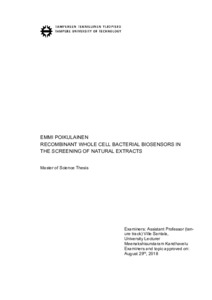Recombinant whole cell bacterial biosensors in the screening of natural extracts
Poikulainen, Emmi Loviisa (2018)
Poikulainen, Emmi Loviisa
2018
Biotekniikka
Teknis-luonnontieteellinen tiedekunta - Faculty of Natural Sciences
This publication is copyrighted. You may download, display and print it for Your own personal use. Commercial use is prohibited.
Hyväksymispäivämäärä
2018-11-07
Julkaisun pysyvä osoite on
https://urn.fi/URN:NBN:fi:tty-201810242440
https://urn.fi/URN:NBN:fi:tty-201810242440
Tiivistelmä
Natural extracts have been used in traditional medicine as remedies to treat for example inflammations. During the era of modern medicine, there has been a shift towards usage of synthetic substances. However, many bacteria have already developed resistances against antibiotics or other antibacterial substances. These resistant bacteria cause serious health issues, especially in the hospital environment.
The natural extracts used in traditional medicine are new sources for antibacterial sub-stances. One of these extracts is round-leaved sundew extract, which has been used for example as cough remedy. The compounds of sundew extract, such as naphthoquinones and flavonoids, have proven health effects. The extract of round leaved sundew includes naphthoquinones, such as 7-methyljuglone and plumbagin in small concentrations, as well as flavonoid quercetin.
New measurement methods, which can measure bioavailability and toxicity at the same time, can be useful in the screening of natural extracts. The natural extracts are usually screened as crude extracts, and therefore the concentrations of the active substances can be low, and there can be plenty of different samples to screen. Thus, the methods have to be sensitive, fast and easy to perform and easily adoptable into different laboratories.
This diploma thesis was done as a part of collaboration between Tampere University of Technology and the Natural Resources Institute of Finland (Luke). In this thesis, the an-tibacterial effects of ethanol extracted Drosera rotundifolia from pure tissue culture and plants gathered from two different peatlands were studied using genetically modified bi-oluminescent bacterial cells. Luke Parkano research station provided the round leaved sundew extracts as well as the standard substances, which were quercetin, plumbagin, lawsone and juglone. Recombinant biosensor cells are bacterial cells, which have been genetically modified to include reporter genes from another organism. In this work, four different biosensor strains were used, and they all included a bioluminescent genetic re-porter. The strains were Staphylococcus aureus RH4220, Escherichia coli K12 + pcGLS11, Acinetobacter baylyi ADP1 + pBAV1K-T5-LUX and Pseudomonas putida. The last one was genetically modified during the work by transforming a bioluminescence plasmid pBAV1K-T5-LUX into the P. putida cells using electroporation.
The sundew extracts and the standards showed antibacterial effects on all of the strains. However, there were dissimilarities in the effects between the strains. Therefore, in further studies, it is important to consider the sensitivities of different bacteria. These variances might be caused for example by the gram positive bacteria having dissimilar reactions towards the compounds extracted from the round-leaved sundew than the gram negative.
The natural extracts used in traditional medicine are new sources for antibacterial sub-stances. One of these extracts is round-leaved sundew extract, which has been used for example as cough remedy. The compounds of sundew extract, such as naphthoquinones and flavonoids, have proven health effects. The extract of round leaved sundew includes naphthoquinones, such as 7-methyljuglone and plumbagin in small concentrations, as well as flavonoid quercetin.
New measurement methods, which can measure bioavailability and toxicity at the same time, can be useful in the screening of natural extracts. The natural extracts are usually screened as crude extracts, and therefore the concentrations of the active substances can be low, and there can be plenty of different samples to screen. Thus, the methods have to be sensitive, fast and easy to perform and easily adoptable into different laboratories.
This diploma thesis was done as a part of collaboration between Tampere University of Technology and the Natural Resources Institute of Finland (Luke). In this thesis, the an-tibacterial effects of ethanol extracted Drosera rotundifolia from pure tissue culture and plants gathered from two different peatlands were studied using genetically modified bi-oluminescent bacterial cells. Luke Parkano research station provided the round leaved sundew extracts as well as the standard substances, which were quercetin, plumbagin, lawsone and juglone. Recombinant biosensor cells are bacterial cells, which have been genetically modified to include reporter genes from another organism. In this work, four different biosensor strains were used, and they all included a bioluminescent genetic re-porter. The strains were Staphylococcus aureus RH4220, Escherichia coli K12 + pcGLS11, Acinetobacter baylyi ADP1 + pBAV1K-T5-LUX and Pseudomonas putida. The last one was genetically modified during the work by transforming a bioluminescence plasmid pBAV1K-T5-LUX into the P. putida cells using electroporation.
The sundew extracts and the standards showed antibacterial effects on all of the strains. However, there were dissimilarities in the effects between the strains. Therefore, in further studies, it is important to consider the sensitivities of different bacteria. These variances might be caused for example by the gram positive bacteria having dissimilar reactions towards the compounds extracted from the round-leaved sundew than the gram negative.
